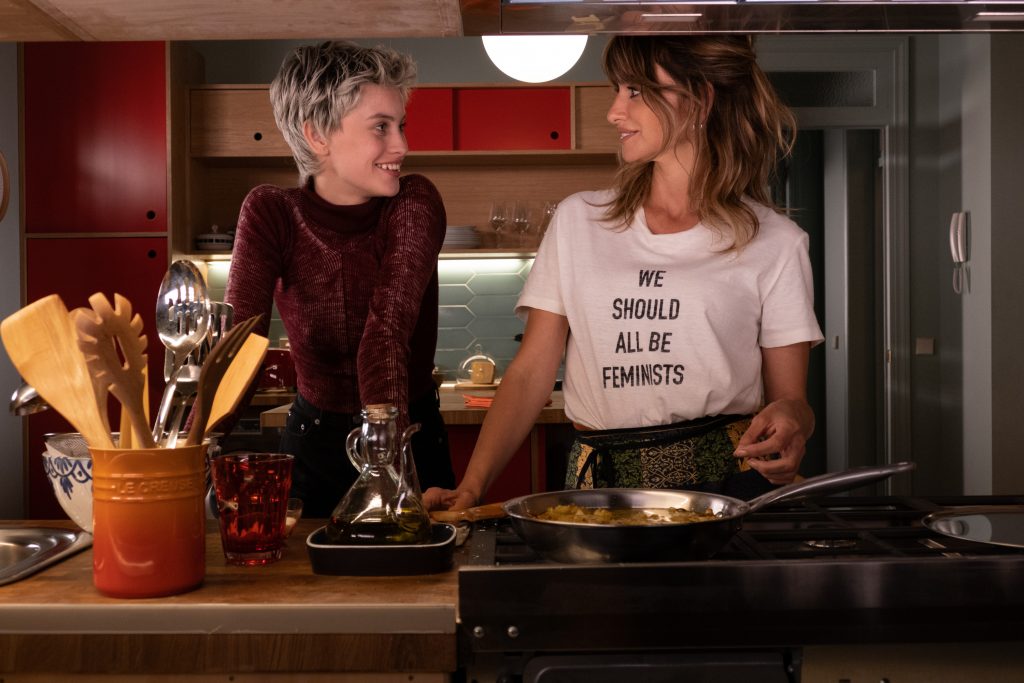Known as one of the finest Spanish filmmakers, Pedro Almodóvar, at the age of 72, in his new film, Parallel Mothers, reflects personal politics through a melodrama about motherhood. It makes for an interesting recipe by incorporating the hard-hitting political happenings of the past with an accessible melodrama of two women who find themselves interconnected gradually as the film’s historical themes emerge.
Janis (Penelope Cruz), a fashion photographer, is in search of her past. The story begins in the winter of 2016 when Janis is commissioned to do a series of portraits of a forensic archeologist named Arturo (Israel Elejalde). After a photoshoot with him, she asks him to help excavate the remains of her great grandfather in her native village. The two eventually end up sleeping together, leading to Janis becoming pregnant with a daughter she is determined she will raise as a single mum, just as her mother and grandmother did before her. But, there’s a twist- the babies were swapped at the hospital where Janis was in the room next to Ana (Milena Smit), someone who’s much younger than the former.
Related to Parallel Mothers: Understanding the Various Themes of Pedro Almodóvar’s Latest Film
Will the two women swap babies again and love them anew? Will Janis confess to Ana that the babies were swapped? The two women come from circumstances that are radically different but have one major thing in common in that they both come from unfulfilled households. This creates stark contrasts between the two; even when the two actresses share ineffable chemistry on screen together, the screenplay ends up putting them in conflict with each other. Yet we fall in love with both of them. Your heart goes out to the mother who has lost her baby to crib death, as also to the one who knows that the baby sleeping so close to her, is not hers.
The film creates good enough suspense leading up to the eventual reveal of the two babies being swapped. It’s Arturo who puts the very idea into Janis’s head, that this baby may not be his. So as the audience, we keep doubting his intentions, a sign of how well the movie works in making us empathize with Janis’ character within the first few minutes.
114,226 citizens fell victim to the violent anti-communist persecution of the Spanish Civil War, a fascist terror that rotted Spain in the middle decades of the 20th century. Madrid, The Valley of the Fallen, contains the remains of 33,000 victims of this period of rule. Almodóvar’s own film career flourished after Franco’s decline and was even initially pushed out of film school after Franco’s regime shuttered his institution in the early ‘70s. Even then, Almodóvar had never made an all and out political film focusing on this horrifying history of his country. With “Parallel Mothers”, he tells a melancholy tragedy showing the unavoidable entanglements and complications of life and the politics one throws at a society.
The documentary-like display of human bones and the artifacts with which the dead were buried, creates further contrasts with the film’s overarching story and the very characters that inhabit it, making you see how you cannot separate the politics of the world from the happenings around you. Almodóvar goes further by yoking sublime moments of theatrical artifice, as we see closeups of old jewelry, a glass eye, a child’s rattle, and pieces of the shell casing. He even cleverly addresses the constant tussle between the left and right, when we see Ana’s mother, a theater actress too obsessed with her art, categorize herself as “apolitical”. It’s implied that she was thus never instilled with a sense of indignance for her country’s past evils. Almodóvar later declared in an interview, “In Spain, when someone says that he’s apolitical, it means that he’s on the right.” I took a deep sigh watching that scene.
Also Read: 20 Important Queer Movies of the 20th Century
The very aspect that makes “Parallel Mothers” worth discussing is also the one that bogs down the film’s pacing. Going overtly political with the film also meant that Almodóvar had to lose a lot of his sense of humor that’s often considered the filmmaker’s greatest gift. Even in films like “Talk To Her”, he had managed a tight command over the film’s narrative. This time around, he goes into the hefty didactic territory, as he struggles to mesh the thematic nature of the film with the other melodramatic half of the screenplay. The opening first act here is reminiscent of “Law of Desire” and there’s also that predominant red palette one would come to expect from an Almodóvar film. But given the plot’s nature, the film naturally doesn’t reward you much if you’re not completely aware of Spain’s history going in, which I thought was a weak aspect in terms of the screenplay not making those bits gel smoothly into the last act.
Having said that, “Parallel Mothers” definitely has one of the most horrifyingly poetic closing shots I’ve watched in a film in a while. Janis spends the film paralyzed by her guilt. The two women, who have babies that suffer from minor health complications, search for a distant and traumatized past in the midst of wounding presents and uncertain futures. Even though the underlying political enigma never really lifts the film off to the height it hopes at reaching, it still is a solidly crafted piece of drama reminding us that it’s only through confronting the crimes of the past, that the faltering modern-day civilization can set things straight and move on. By the end, Ana rediscovers not only her motherhood but the history of the place that has emerged from the pit.







![Velvet Buzzsaw Netflix [2019] Review – A problematic satire on the art community](http://www.highonfilms.com/wp-content/uploads/2019/06/Velvet-Buzzsaw-Netflix2-768x410.jpg)